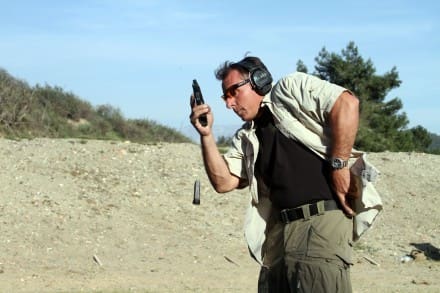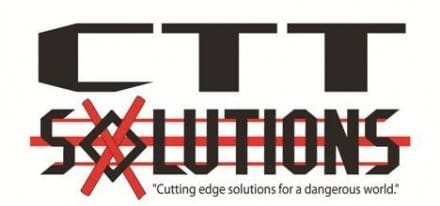Steel is an incredible tool for marksmanship training due to the instant feedback and (other than an occasional repainting) because it removes the requirement to go downrange and score or service (read “paste targets”). One problem I frequently see that leads to bad or sloppy habits is poorly chosen sizes of steel. I constantly see people at ranges or in videos shooting speed drills using steel that is very large, giving the shooter and viewer a deceiving appearance of skill and or speed. For example, if you do a one-shot draw at 10 yards on a B/C zone plate as opposed to an A-zone plate, there is a completely different level of precision and skill required.
I demonstrated this concept with a Glock that had no sights at all and performed 1-shot draws on a B/C-zone steel in 1 second or less from 10 yards with ease. This drill demonstrates the benefit of good body mechanics, proper presentation, and is actually very easy to perform. This drill emphasizes the point that at combative ranges, that body position is where the speed comes from: proper use of large steel. Now change the steel to an A-zone (60% smaller surface area), and it becomes far more problematic and really a function of luck for the same 1 second shot. The point being, if you want to get faster and more accurate, doesn’t shoot targets of a size that allow hits with little to no sight picture. Work your draws on an A-zone steel or smaller. I frequently do my reload drills on a 6” round steel to force me to follow that front sight 100% of the time or miss. The benefit is continuous reinforcement of the requirement to follow the sights to get the hits…come off the sight—come off the target. The gun will follow the eyes every time so keep the eyes where they should be! I recently did a drill called “Sight Tracker” that reinforces this very concept. You can’t make the hits if you don’t watch the sights.
Take a look at it here:
The takeaway is that everybody looks like a superhero shooting big steel. Often times the result is a reinforcement of sloppy habits and bad technique along with a false sense of the speed at which you can reliable shoot and hit. Use steel that GENUINELY makes you aim and forces you to see those sights every time you break a shot and then follow them to the next shot or next target.
If you choose steel that lets you get away with little or no sight picture, that is what you are practicing…if you use small steel that makes you follow the sights every shot and work for every hit, that is what you are practicing.
In conclusion, you should choose your steel wisely!
For reference here are some numbers all in square inches to help evaluate relative difficulty:
• 6” round- 28.27 sq. in.
• 8” round- 50.26 sq. in.
• 8” square- 64 sq. in.
• A-Zone- 66 sq. in.
• ¼ size IPSC- 110 sq. in.
• A/B/C-zones – 220 sq. in. (approximate)
• Full size IPSC 430 sq. in. (approximate)
– Mike Pannone
Mike Pannone retired from the Army’s premier assault force (1st SFOD-D) after an explosive breaching injury. A year after his retirement America was attacked on 9/11 and he returned to help serve his country as the head marksmanship instructor at the Federal Air Marshals training course and then moved to help stand up the FAMS Seattle field office. In 2003 he left the FAMS to serve as a PSD detail member and then a detail leader for the State Department during 2003 and 2004 in Baghdad and Tikrit.
In 2005 he served as a ground combat advisor of the Joint Counter IED Task Force and participated on combat operations with various units in Al Anbar province. Upon returning he gave IED awareness briefings to departing units and helped stand up a pre-Iraq surge rifle course with the Asymmetric Warfare Group as a lead instructor. With that experience as well as a career of special operations service in Marine Reconnaissance, Army Special Forces and JSOC to draw from he moved to the private sector teaching planning, leadership, marksmanship and tactics as well as authoring and co-authoring several books such as The M4 Handbook, AK Handbook and Tactical Pistol shooting. Mike also consults for several major rifle and accessory manufacturers to help them field the best possible equipment to the warfighter, law enforcement officer and upstanding civilian end user. He is considered a subject matter expert on the AR based Stoner platform in all its derivatives.
Gunfighter Moment is a weekly feature brought to you by Alias Training & Security Services. Each week Alias brings us a different Trainer and in turn they offer some words of wisdom.
Tags: Alias Training and Security Services, CTT Solutions, Mike Pannone




Wow.
Noner,
You never fail to deliver the goods.
Solid, again.
Dave
Left Eye Consulting is always solid!
Exactly.
By far one of the best training articles I’ve read in 30+ years
The video, on the other hand, I couldn’t use as a training aid. Cops at least need to see a shooter cover there targets for a couple seconds before dropping the gun to a low ready or reholstering. I’m also sure that it varies from range to range, but in my world a spent mag stays on the ground until the pistol is topped off, holstered, and the line, such as it is, is secure.
Maybe I missed it: what was the distance on that.
Bill, it’s a drill not a scenario i.e it is the exercise of component skills not an evaluation of tactical judgement. I hope that clears up any confusion.
Like ^^^^
I understand, but hate to drag out the old “train the way you fight” saw, but will do it anyway. Any given drill is a chance to practice all elements, no matter how small or insignificant. Different strokes….spectacular shooting nonetheless.
Another outstanding article from Mr. Pannone, full of analysis, good training suggestions, and useful to multiple levels of shooter ability.
I noticed this the first time I went to a local 3-gun where they used huge steel plates relative to the 6-8 inch ones I used, and it was amazingly easy, while it would have been a real challenge had they used small ones
Great article…Great Video! He does a reload, fires one round, then misses the other round over the same targets right shoulder while transitioning to the next target.
Look at the video in full screen and you will see the second round hits the steel by the splash at the base. Based on the camera angle I would have to miss the steel and the bullet turn 30 degrees and rise 15 feet to hit the berm in that location. Look a little closer and you will see it hits the left edge…a hit nonetheless.